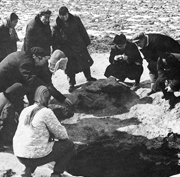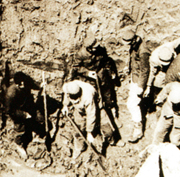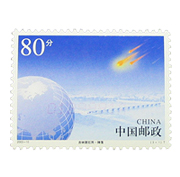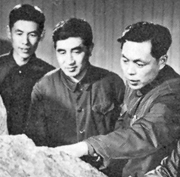Official Name:
Jilin is the name of the city where this meteorite fell. The only known synonym for this meteorite is Kirin. This name refers to the same city, but is a different transcription from the Chinese alphabet to our own.
Location:
On the outskirts of Jilin, in the province of Manchuria, northeastern China.
Fall or Find:
Fall
Date:
8 March 1976 about 3:00 p.m., local time.
Mass Recovered:
About 4 metric tons of meteoritic matter were collected. This is the largest meteorite shower ever witnessed. The biggest fragment weighed 1 770 kilograms. To this day, it is the heaviest fragment of a stony meteorite that survived all the way to the ground.
Number of Fragments:
There were over 100 fragments in this fall.
Strewn field:
The Jilin strewn field is impressive: it measures 72 kilometres by 8 kilometres.
Crater:
The biggest fragment produced an impact crater in the frozen ground. The crater was 6 metres deep and 2 metres wide. It was located a few hundred metres from the nearest habitation. The impact raised a mushroom-shaped cloud of dust over 50 metres high.

Enlargement
Jilin's main mass produced an impact crater in the frozen ground. |
|

Enlargement
The largest fragment of the Jilin stony meteorite was recovered from the bottom of its impact crater after major excavations. |
|
Circumstances:
A reddish fireball travelling 17 kilometres per second towards the southwest was observed by the villagers of Hsinglung. Loud explosions could be heard as the meteoroid travelled across the sky. At the end of the luminous phenomenon, three distinct fireballs were visible.
Jilin's main mass is the largest meteorite whose fall has been observed.

Enlargement
One of the Chinese postal stamps commemorating the Jilin meteorite shower. It depicts the fragmented meteoroid heading toward China. |
|

Enlargement
Scientists examining the main mass of Jilin. |
|
History:
In the 5 000 years of Chinese history, several meteorite falls have been associated with important historic events. According to tradition, meteorites announce the end of a dynasty. The Jilin fall was interpreted after the fact as an omen of the death of Mao Tse-tung, which occurred just a few months after the fall!
Type:
Stony meteorite
Class:
Ordinary chondrite
Group:
H5
Composition:
This chondrite is composed of olivine and bronzite, a pyroxene characterized by its shimmering bronze lustre. Jilin has a very high iron content: this metal accounts for 28.6% of the meteorite's volume. Organic compounds, including amino acids, were found in this meteorite even though it is not a carbonaceous chondrite. The origin of these compounds is not known, but they may be the result of terrestrial contamination.
Scientific contribution:
The last thermic event to affect the Jilin meteorite dates back 33 000 years. It may correspond to the collision of two asteroids and the breaking away of the Jilin fragment. The mass of the meteoroid on its entry into the Earth's atmosphere has been estimated to be 15 metric tons. This means that the parent body of the Jilin meteorite must have been huge.
Comments:
What does a city do when several tons of meteorite fall on it? It builds a museum to house the rocks from space! If you ever visit Jilin, stop by the Yunshi Bowuguan ("meteorite museum") to admire this colossal meteorite.
Part of the Planétarium's collection:
Yes